Self Assessment SA1 Registration Explained – Registering for HMRC Self Assessment
The Self Assessment SA1 form is the official HM Revenue & Customs (HMRC) registration form for individuals who need to file a Self Assessment tax return but do not yet have a Unique Taxpayer Reference (UTR). If you are self-employed, a company director, a landlord, or have other taxable income outside PAYE, you must complete the SA1 Self Assessment Form to register with HMRC.
Download the SA1 form here – https://www.gov.uk/government/publications/self-assessment-register-for-self-assessment-and-get-a-tax-return-sa1
What is the SA1 Form?
The form SA1 HMRC is used to:
- Register for Self Assessment if you have untaxed income.
- Get a Unique Taxpayer Reference (UTR) from HMRC.
- Inform HMRC that you will need to complete an annual tax return.
The self assessment SA1 is different from the SA100 (used to file returns) and SA302 (used as evidence of income). The SA1 HMRC form is the very first step in the Self Assessment process.
Who Needs to Complete the SA1 HMRC Form?
You must complete the SA1 registering for self assessment if you:
- Are self-employed or planning to start a business.
- Receive rental income from property.
- Earn dividends or have savings/investment income above allowances.
- Are a company director or partner in a business.
- Have foreign income that needs to be declared.
- Need to claim tax reliefs (e.g., pension, charity donations).
Guidance on Self Assessment registration: https://www.gov.uk/register-for-self-assessment
How to Complete the SA1 Self Assessment Form
- Download or complete online:
- Paper form SA1
- Online registration
- Provide personal details: Name, address, NI number.
- Explain why you need to register (e.g., rental income, self-employment).
- Add details of income type.
- Submit online or post the form to HMRC.
Once HMRC processes the self assessment SA1 form, they will send you a UTR number, which you’ll need to file your first tax return (SA100).
Deadlines for Registering with the SA1
- You must register by 5 October following the end of the tax year in which you had taxable income.
- For example: if you started self-employment in June 2024, you must complete the SA1 Self Assessment Form by 5 October 2025.
Missing this deadline can result in fines and penalties for late registration.
Common Mistakes with the SA1 HMRC Form
❌ Registering too late and missing deadlines.
❌ Providing incorrect personal details, leading to delays.
❌ Forgetting to explain clearly why you need Self Assessment.
❌ Confusing SA1 with SA100 (SA1 is registration, SA100 is the tax return itself).
❌ Not keeping a copy of the submitted form.
Example Cases – Why the SA1 is Important
Case 1: Self-Employed Consultant
Emma started freelancing in 2023 but didn’t complete the SA1 Self Assessment Form until 2025. HMRC fined her for late registration. Audit Consulting Group helped her file properly, appeal the penalties, and set up her UTR.
Case 2: Property Landlord
James began renting out his second property in 2024. He filed the form SA1 HMRC before the 5 October deadline. As a result, HMRC issued his UTR promptly, and he filed his SA100 without problems.
Case 3: New Company Director
Sophie became a director of her own limited company. She used the SA1 HMRC to register for Self Assessment. ACG assisted with the process and ensured her first tax return was correctly prepared.
Practical Tips for Completing the SA1
✅ Register early – don’t wait until October.
✅ Always double-check your National Insurance number.
✅ Keep a copy of the confirmation from HMRC.
✅ Clearly state the source of your income (self-employed, landlord, etc.).
✅ If unsure, get professional advice to avoid delays.
FAQ – Self Assessment SA1
Q1: Do I need to submit the SA1 if I’m already self-employed?
No – you register once. If already registered, you don’t need another SA1.
Q2: How long does it take to get a UTR after sending the SA1?
Usually 10–14 days, but sometimes longer.
Q3: Can I register online instead of using the paper SA1 form?
Yes, most people register online for speed.
Q4: What if I miss the 5 October deadline?
You may face penalties and HMRC will expect your return regardless.
Q5: Can Audit Consulting Group help with the SA1?
Yes – we register you for Self Assessment, obtain your UTR, and guide you through your first return.
Why Choose Audit Consulting Group?
At Audit Consulting Group, we know that the SA1 Self Assessment Form is the first step to staying compliant with HMRC. We:
- Handle the registration process from start to finish.
- Ensure your form SA1 HMRC is completed accurately.
- Help avoid delays and penalties.
- Support you with your first SA100 tax return.
- Provide long-term advice for tax efficiency.
Registering late or incorrectly can cost you. Contact Audit Consulting Group today and we’ll make sure your SA1 registering for self assessment is smooth and stress-free.






